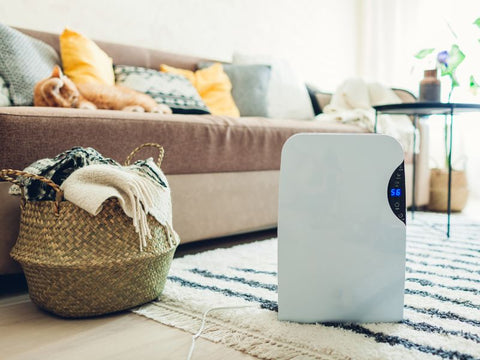As winter settles in, drying your clothes becomes more challenging due to the cold and damp weather. Hanging your laundry outside on a sunny day is no longer an option so it's essential to find quick and easy ways to dry your clothes indoors.
With many options available to dry your clothes inside, from dehumidifiers to tumble dryers, in this post, we delve into which methods are the cheapest and quickest and give you some great tips for drying clothes in winter.
Air Drying

Air drying your clothes using a clothes dryer is the cheapest method of drying your clothes as it is free. However, it also takes the longest, and if your home is cold or drafty it can take a while to dry your clothes. It can also cause problems with mould if the room is not properly ventilated.
Heated Airers
Heated airers are a popular choice for drying clothes during the winter months. Heated airers are basically electric clothes drying racks that use low power to heat the rails of the dryer.
Why they are great:
- Heated airers are cheap to run due to the low voltage.
- Some come with covers that can increase efficiency and help dry clothes quicker.
- They are easy to use, you simply hang your clothes on them, and they can be used for all clothes types.
- Many heated airers come with timer settings. Use these to prevent over-drying and save on energy costs.
Low points to note:
- Heated airers need to be carefully placed in a well-ventilated room, away from any flammable items or furnishings.
- Overloading an air dryer will limit its ability to dry clothes, and space needs to be left between clothes for adequate air circulation.
Dehumidifiers

Dehumidifiers help to dry clothes by removing excessive moisture in your home, which is great for both your home and your clothes. Here's how to use dehumidifiers in your winter laundry routine:
Why they are great:
- Dehumidifiers help to maintain the ideal indoor humidity level which not only helps clothes dry but also helps prevent mould and mildew growth.
- When placed near your laundry area, it can effectively remove moisture from the air as your clothes dry.
- They are gentle on your clothes and can be used around your home to reduce moisture.
Low points to note:
- The water tank needs to be emptied regularly to prevent overflow and maintain the dehumidifier's efficiency.
- They take up space and you still need to use a clothes airer with a dehumidifier.
- Running costs vary depending on the model you buy.
Tumble Dryers

Tumble dryers are a common household appliance that offers a quick and convenient way to dry your clothes.
Why they are great:
- Full loads of laundry can be dried all at once.
- Drying times are quick, although this depends on the size of your laundry load and what you are drying.
- Tumble dryers are easy to use, and you can leave your clothes in them without the need to check them.
Low points to note:
- Tumble dryers can be expensive to run, and are the most expensive method of drying your clothes.
- You must separate your laundry based on fabric type, and drying needs. Some clothes cannot be tumble dried as they will shrink so they will need to be air dried separately.
- You need to keep on top of cleaning your tumble dryer, specifically regularly cleaning the lint filter to maintain airflow and improve drying efficiency.
- Your tumble dryer will need the right ventilation to release warm, moist air. Otherwise, excess moisture will accumulate in your home.
- Tumble dryers are not the most eco-friendly option given their high energy usage.
Drying clothes during winter can be challenging, however, with the right tools and techniques, you can dry your laundry quickly without too much cost. Heated airers, dehumidifiers, and tumble dryers each offer their own advantages. With a little planning and the right equipment, you can ensure your clothes are always ready to wear, no matter the weather outside.











